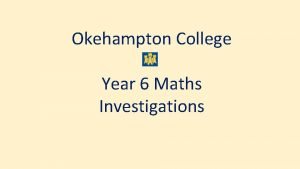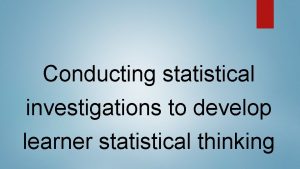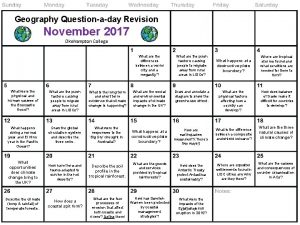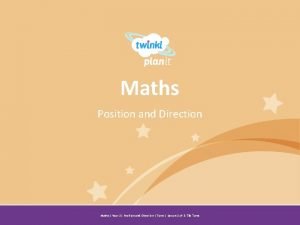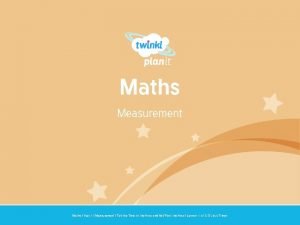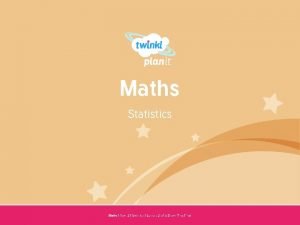Okehampton College Year 6 Maths Investigations Lesson 1








- Slides: 8

Okehampton College Year 6 Maths Investigations

Lesson 1 – Consecutive Sums https: //nrich. maths. org/summingconsecutive/solution

Getting Started. * Firstly start by trying some simple cases – maybe numbers up to 10 Is there more than one way that you can obtain the target number? * Then extend up to 20 or more. Are there any numbers which cannot be written as a sum of consecutive integers? If so can you explain why? Do you see any patterns? Can you explain these patterns? Make a poster of your findings.

Lesson 2 - More Consecutive numbers You need to choose any four consecutive numbers and place them in a row with a bit of space between them, like this; 4 5 6 7 Now place + and – signs in between them, so like this: 4+5– 6+7 4– 5+6+7 and so on until you have found all the possibilities. Are you sure you’ve got them all? You should include one using all +’s and one that includes all –’s. Now work out the answers to all your calculations Now try other sets of four consecutive numbers and look carefully at the sets of answers that you get each time. Are you surprised by anything you notice? Make a note of your findings and test them out with new sets of four numbers. Can you explain any patterns? Questions to ask yourself on next slide…. .

It is always good to ask yourself questions based on the results you get – be curious! “I wonder what would happen if I …. ? ” Here are some we thought of – you do not need to answer all of these, maybe pick one, or a different one that you have thought of. Write down what you think would happen then test this by trying it out. Were you right? If you were not right can you see why? • What would happen if I took the consecutive numbers in an order going down, instead of up? • What would happen if I only used sets of three consecutive numbers? • What would happen if I used more consecutive numbers? • What would happen if I changed the rule and allowed consecutive numbers to include fractions or decimals? • What would happen if I allowed a + or – sign before the first number? • What would happen If I chose all negative consecutive numbers? Discuss your findings as a class and write up your notes neatly on a poster. https: //nrich. maths. org/consecutivenumbers/solution

Lesson 3 Mystic Roses Time to be creative – you will need a ruler and a sharp pencil. Plus sharp coloured pencils for pretty versions.

As well as drawing these incredible patterns there is also maths involved! Your teacher will provide you with circle templates with differing number of points around the circle. Whilst you are constructing your mystic roses, think about the lines you are drawing; can you spot a pattern? Can your predict how many lines you will need for different numbers of points?

Circle templates here – scroll down for the circles without centre dots https: //nrich. maths. org/8506 Children Ask your teacher to search google images for Mystic Roses –see how beautiful they can be if you add colour. We would love to put some of your work on one of our maths displays in the college for September. Therefore, either construct a mystic rose , add colour if you wish, or make a poster of your findings to the question posed on the poster on the previous page. Ask your teacher to kindly send all your work to the college for the attention of Mrs Carter We are looking forward to seeing you all in September!
 Nrich maths investigations
Nrich maths investigations Why aren t descriptive investigations repeatable
Why aren t descriptive investigations repeatable Private investigator craigslist
Private investigator craigslist Guide to computer forensics and investigations 6th edition
Guide to computer forensics and investigations 6th edition Statistical average crossword
Statistical average crossword Types of statistical investigation
Types of statistical investigation Chapter 6 fingerprints
Chapter 6 fingerprints Bmv toledo ohio heatherdowns
Bmv toledo ohio heatherdowns Conclusion in scientific method
Conclusion in scientific method
